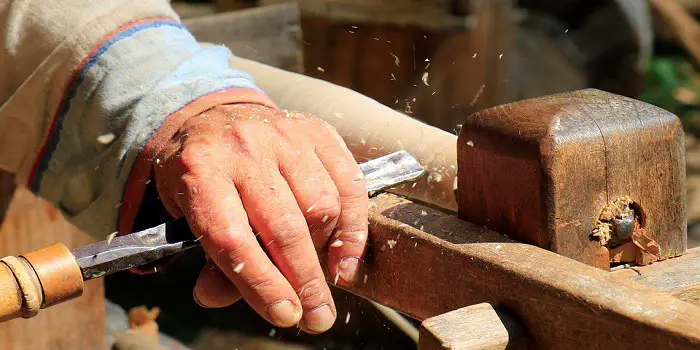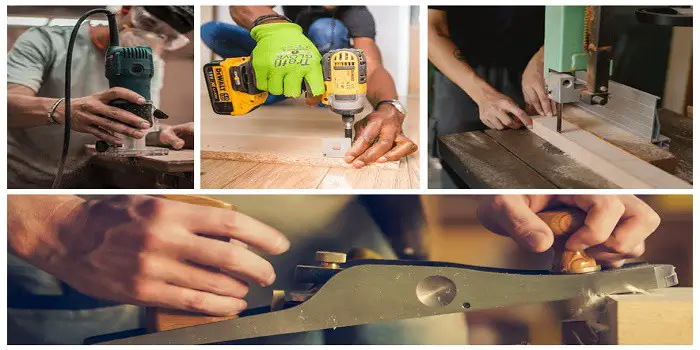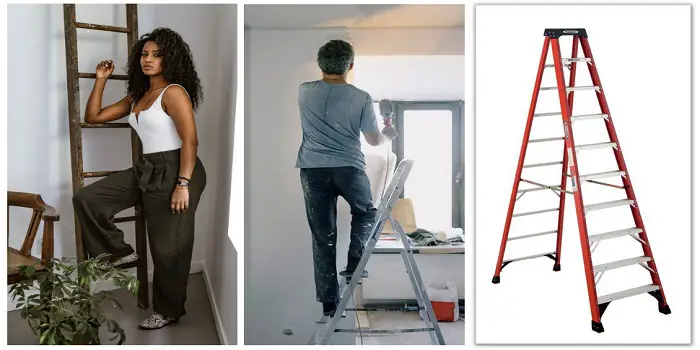
Ladders, both for household and commercial usage, are manufactured from a number of different materials. But the most common ones include three, i.e., wood, aluminum, and fiberglass.
Unlike traditional ladders that are usually made from timber, fiberglass material is lightweight and safer. Plus, they also last longer than wooden ladders.
The only downside is fiberglass step ladders are more expensive than other materials. And that’s the reason many people prefer buying wood or aluminum ladders, especially for short-term usage or for smaller projects.
When choosing the type of ladder material, it is important to know the pros and cons of each type so that you can make the best-informed decision.
Wood, Aluminium & Fiberglass Ladders – Compared
Ladders are important to gain access to hard-to-reach household areas and commercial spaces.
Whether it’s for cleaning the gutters on your roof, trimming the garden trees, or for changing the high light bulb above your staircase – you will need a ladder all the time.
With so many different styles and materials available, what’s going to be the best ladder for your needs?
Well, there is no single material that can be well suited for every situation.
You will need to choose the type of material that matches your requirements exactly and the environment in which you will be working.
Unlike aluminum and fiberglass, wood ladders may rot or get splintered if not stored well. Plus, they can become loose or wobbly with time. So, avoid using them outdoors and make sure you store them properly.
If, on the other hand, electricity or electric shock is a concern, avoid using an aluminum ladder and pick the timber version.
Let’s check out more by looking at the advantages of each material right away…

Timber Ladder
- Cheap
- Widely available
- Unlike metal, it does not rust
Aluminium Ladder
- Cheaper than fiberglass
- Lightweight and easy to transport
- Unlike wood, it’s less likely to crack
Fibreglass Step Ladder
- Stronger
- Does not weaken or get bent with heat
- Resistant to weather, flame, and electric shock
- Lighter and can be transported easily to places, whether indoors or outdoors
In comparison to aluminum and wood ladders, fiberglass ladders are more resistant to environmental factors like heat, moisture, wind, and rain. These are hence stronger.
Aluminum and wood ladders are also made strong, but their strength will depend on the grade of material that has been used in the making.
Timber, for example, comes in wide variations and qualities.
Where dense hardwood such as hickory, oak, or mahogany is most suitable for making wooden ladders, varieties like pine and balsa are not recommended.
This also means if a wooden ladder rung or a support beam is made using weaker material, it can break or fall off very easily.
Fiberglass or reinforced plastic ladder, on the other hand, is made using uniform sections of fiberglass that don’t vary in quality, size, design, or strength.
What About Steel Ladders – Are They Good?
Since stainless steel ladders are heavier and generally more durable than aluminum or fiberglass, these are the best options for commercial capacities like warehouses.
Steel ladders are more rigid and are designed to withstand hundreds of pounds which makes them a viable option for industrial purposes as well.
With mounted rolling wheels and solid rails, most of these ladders are easy to move around.
For DIY and household tasks, stainless steel ladders are not very suitable as they are highly expensive and heavier compared to other materials.
If you picking the ladder for a warehouse or any other enclosed commercial location, make sure that you do not place them near electrical installations or high-voltage sources.
Steel is an iron alloy, is an excellent electrical conductor, and is susceptible to electrical shocks. Plus, if you choose cheap material, it can also rust with time.
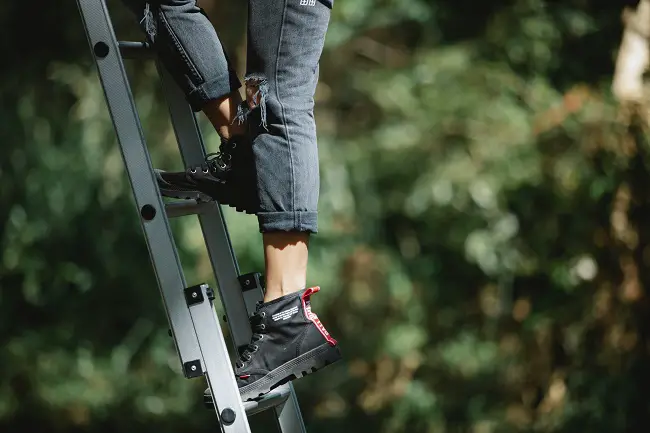
Tips for Setting Up and Using Your Ladder Safely?
Now that you know a little bit about the materials and types of ladders, it’s time to understand how you can set the ladder and use it safely.
While the process may differ slightly based on the type you choose, you will need to follow the basic steps as follows…
1- Observe and Get Ready
Before you install a ladder, carefully observe the surroundings, especially the things that are above you at a height that you want to reach.
There may be electric wires around which you want to be cautious.
Also, when setting up a ladder against your house, check for open windows, trees, a nearby pole, roof height, and where the gutters are located.
If you do not set up the ladder carefully against these surfaces, it can cause collapse and fall.
2- Get the Right Angle
Setting up your ladder at a right angle is also important. It should neither be too far nor too close to the surface like walls.
As a general rule, your ladder should be at a 75-degrees angle or should follow a 1-to-4 rule.
This rule simply states that for every four feet of height, you need to climb, place the base of your ladder one foot away from the wall that the ladder is placed against.
3- Secure the Feet and Top
If not secured well on the surface, your ladder can slip backward during a job and cause a falling hazard.
To prevent this, turn up the ladder shoes and make the spurs stick into the ground if you are working up the ladder on grass or soil ground.
When working on slightly sloped or shiny surfaces, you can consider scrubbing the depth of ladder feet.
Also, ensure that the area is clean without any dust, sand, water, or any such thing that can potentially cause slippage.
Not only the feet, but you will need to secure the top of the ladder (on an even surface) for complete protection.
A few add-on accessories that can help you achieve this include ladder stabilizers, jacks, planks, harnesses, and rubber/plastic mitts that can go over the top of the ladder rails for better grip.
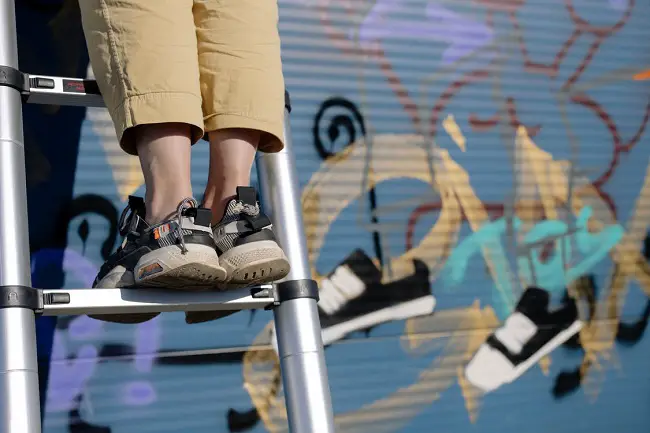
Besides Materials, What Other Things to Look For When Buying a Ladder?
Besides the right material, there are some other essential factors you will need to look at prior to purchasing your best extension ladder.
The key elements are:
1- Height
As a very first step, the height you require to reach will determine the size of the ladder you need to buy.
Generally, you should pick a ladder that is 4-5 feet taller – than you actually need.
For example, if you need to paint the exterior walls of your two-story house (around 18 – 20 feet in height), you should add a few feet and buy a ladder that is at least 22-25 feet high.
2- Ease of use and safety
When you have determined the height, it’s important to check the features and safety of the ladder.
It should be user-friendly, which means extending and collapsing (or folding) the ladder should not be hard and time-consuming.
Unlike scaffolds, the ladder you choose should also be easy to carry and move around.
For the safety of the ladder, you will need to check the built-in features such as:
- D-shape rung
- Slip-resistant pad and anti-slip foot shoe
- Lock system to secure when folded or extended
3- Weight, load capacity, and type
Load capacity is also a crucial factor to consider, and it will depend on the material and type of ladder you are selecting.
While taking into account your job requirements you can choose a step stool, step ladder, extension ladder, platform ladder, telescoping ladder, portable warehouse ladder, or others.
Their weight and the load capacity they are designed to carry may vary according to the material they are made from.
It’s best to DYOR before selecting and then picking the right one as per your needs at online stores like Amazon.
4- Size & Usage (Indoors or Outdoors)
In addition to being taller, a step ladder is generally larger overall and is primarily designed for more tasks compared to a step stool.
However, the additional size means that step ladders tend to be heavier compared to step stools.
The general design of the step ladder also makes it better suited for outdoor use.
This is because the design of the footing tends to be more versatile and suited to sidewalks and even bare ground that may have uneven surfaces.
Step stools are generally better indoors on flooring or staircases, which allows the wide base to sit firmly.
So, you can use step ladders outdoors and step stools indoors for painting interior walls and ceilings.
Final Thoughts
As a homeowner, you will typically need to have a step ladder and an extension ladder.
While the former will help you get on a little extra height, the latter can help if you want to work on projects that are higher up, like outdoors.
When it’s about picking the right material, your choice of ladder material should generally depend on where and how you will be using your ladder.
Keep in mind – that aluminum being a conductor of electricity, can get electrical shocks. Whereas fiberglass and wood can degrade if left exposed to outdoor elements for a long.
For indoor purposes, where people need to work at home, fiberglass regularly is by far the better investment.
Share the post "Wood vs. Aluminum vs. Fibreglass Ladder – What to Choose?"

Hi, I am Mark Garner a professional carpenter, woodworker, and DIY painter. I live in the small city of Peoria, Arizona as a semi-retired woodworker. I have started this blog with a simple motive to help you with my wood experience in this sector. If you like to know more about what I love doing and how it all got started, you can check more about me here.


